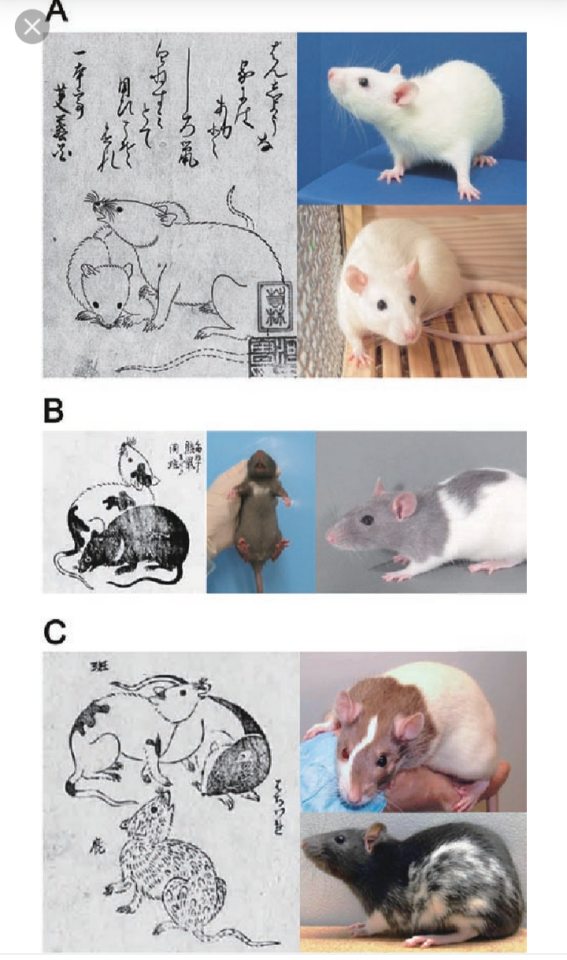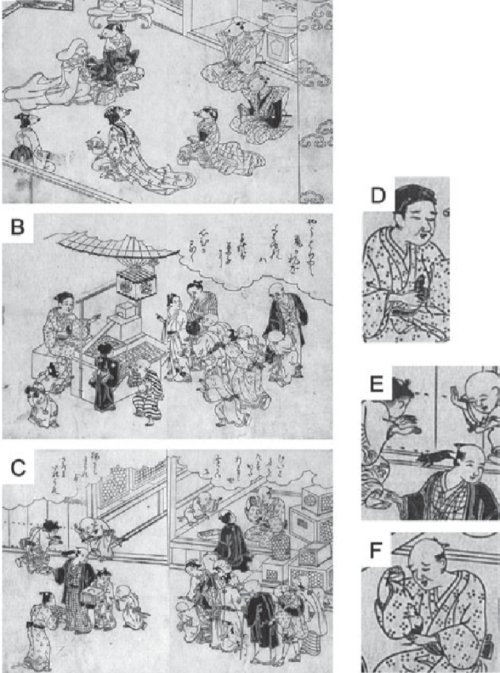Harvest Mouse On A Dandelion By Dean Mason.




Harvest mouse on a dandelion by Dean Mason.
More Posts from Its-mistakeboi and Others
Put your soul at ease late night bagel cream cheese
Currently crying about Yoso-Tama-No-Kakehashi, a Japanese guidebook from the 1700s about raising rats. It's the first known rat guidebook in the world :)


They were raised as pets and for show animals, and it's mentioned in the guidebook that "one can call out and rats will come to hand". They were referred to as "nezumi" and it was considered important that they have large cages to live in. There was also a variety of rat that had a fox-like coat!
Rats were domesticated in Japan from the 1600s to the 1800s - it's unknown if any of those domesticated strains are ancestral to the current domestic rats today. They were domesticated again in Europe in the 1800s (initially for much crueler reasons than just for being pets) and I think it's just so sweet that we as humans fell in love with rats so much that we had to domesticate them at least TWICE...
You can download an article about the guidebook here. https://www.google.com/url?q=https://www.jstage.jst.go.jp/article/expanim/60/1/60_1_1/_pdf&sa=U&ved=2ahUKEwioidaLs5z6AhUojIkEHRI1BvEQFnoECAkQAg&usg=AOvVaw3aarTW0iy1HybCcrxtp4ww

I'm being very brave today


Hey you like Aguefort? I gotchu an Aguefort so you can Aguefort while you Aguefort
This one was a WILD ride XD Such a good time to work on, but EACH AGUEFORT IS AN INDIVIDUAL LAYER. Shout out to Derek and Ruby for animating all of these very silly principals ♥

dungeon foodies



Incamys bolivianus was a caviomorph rodent representing an early member of the chinchillid family, with its closest modern relatives being chinchillas and viscachas.
Living in what is now Bolivia and Argentina during the late Oligocene about 27 million years ago, it inhabited an arid open grassland at a time when the area's climate had drastically cooled due to the formation of the Antarctic Circumpolar Current.
It's estimated to have been similar in size to a large modern chinchilla – weighing around 700g (~1lb 8oz) and measuring about 25-30cm long not including the tail (~10-12").
An endocast of the shape of its brain from a near-complete fossil skull shows that it had a well-developed sense of hearing, particularly in vocalization processing, suggesting it may have been a social animal living in groups communicating with complex calls similar to modern chinchillids. It was probably a ground-dweller less agile than its modern relatives, but still capable of fast movements.
———
NixIllustration.com | Tumblr | Patreon
References:
Bertrand, Ornella C., et al. "The virtual brain endocast of Incamys bolivianus: insight from the neurosensory system into the adaptive radiation of South American rodents." Papers in Palaeontology 10.3 (2024): e1562. https://doi.org/10.1002/spp2.1562
Rasia, Luciano L., Adriana M. Candela, and Carola Cañón. "Comprehensive total evidence phylogeny of chinchillids (Rodentia, Caviomorpha): Cheek teeth anatomy and evolution." Journal of Anatomy 239.2 (2021): 405-423. https://doi.org/10.1111/joa.13430
Wikipedia contributors. “Agua de la Piedra Formation” Wikipedia, 06 Jan. 2025, https://en.wikipedia.org/wiki/Agua_de_la_Piedra_Formation
Wikipedia contributors. “Incamys” Wikipedia, 19 Jan. 2025, https://en.wikipedia.org/wiki/Incamys

Ugh… headache. Head splitting migraine, even.





Let’s get RATICAL 🐀🛹 Prints + stickers available on my patreon this month! ✨
-
 dizzy-jizzy reblogged this · 2 weeks ago
dizzy-jizzy reblogged this · 2 weeks ago -
 lorian-loriest-dingo reblogged this · 2 months ago
lorian-loriest-dingo reblogged this · 2 months ago -
 lorian-loriest-dingo liked this · 2 months ago
lorian-loriest-dingo liked this · 2 months ago -
 catasterismus reblogged this · 4 months ago
catasterismus reblogged this · 4 months ago -
 groovysheepbread liked this · 4 months ago
groovysheepbread liked this · 4 months ago -
 raggletaggleraindrop reblogged this · 4 months ago
raggletaggleraindrop reblogged this · 4 months ago -
 meanderfall reblogged this · 4 months ago
meanderfall reblogged this · 4 months ago -
 alcrux87 reblogged this · 5 months ago
alcrux87 reblogged this · 5 months ago -
 decadentqueentidalwave reblogged this · 5 months ago
decadentqueentidalwave reblogged this · 5 months ago -
 aerstic-spire reblogged this · 6 months ago
aerstic-spire reblogged this · 6 months ago -
 decadentqueentidalwave liked this · 6 months ago
decadentqueentidalwave liked this · 6 months ago -
 sildrato liked this · 6 months ago
sildrato liked this · 6 months ago -
 perhapsalittlesauce reblogged this · 6 months ago
perhapsalittlesauce reblogged this · 6 months ago -
 just-curious-about-you reblogged this · 7 months ago
just-curious-about-you reblogged this · 7 months ago -
 dreams-in-daylight reblogged this · 7 months ago
dreams-in-daylight reblogged this · 7 months ago -
 originalpersonashark liked this · 7 months ago
originalpersonashark liked this · 7 months ago -
 bluecricket2electricchirpaloo reblogged this · 8 months ago
bluecricket2electricchirpaloo reblogged this · 8 months ago -
 bluecricket2electricchirpaloo liked this · 8 months ago
bluecricket2electricchirpaloo liked this · 8 months ago -
 peridontitis reblogged this · 9 months ago
peridontitis reblogged this · 9 months ago -
 headshyhorse liked this · 9 months ago
headshyhorse liked this · 9 months ago -
 milkcartonjanedoe reblogged this · 9 months ago
milkcartonjanedoe reblogged this · 9 months ago -
 cookieswagcake liked this · 10 months ago
cookieswagcake liked this · 10 months ago -
 b00b13l0v3r liked this · 10 months ago
b00b13l0v3r liked this · 10 months ago -
 kalliopii reblogged this · 10 months ago
kalliopii reblogged this · 10 months ago -
 kalliopii liked this · 10 months ago
kalliopii liked this · 10 months ago -
 elise-mopie reblogged this · 10 months ago
elise-mopie reblogged this · 10 months ago -
 motherscarf reblogged this · 10 months ago
motherscarf reblogged this · 10 months ago -
 motherscarf liked this · 10 months ago
motherscarf liked this · 10 months ago -
 lila-cherryblossomtree reblogged this · 10 months ago
lila-cherryblossomtree reblogged this · 10 months ago -
 loveallfandoms1952 reblogged this · 10 months ago
loveallfandoms1952 reblogged this · 10 months ago -
 thatgenderfluidaroace reblogged this · 10 months ago
thatgenderfluidaroace reblogged this · 10 months ago -
 effulgencies reblogged this · 10 months ago
effulgencies reblogged this · 10 months ago -
 dariatarantas liked this · 10 months ago
dariatarantas liked this · 10 months ago -
 824975 liked this · 10 months ago
824975 liked this · 10 months ago -
 summer-l0ver reblogged this · 10 months ago
summer-l0ver reblogged this · 10 months ago -
 mobius-m-mobius liked this · 10 months ago
mobius-m-mobius liked this · 10 months ago -
 vondergeisst liked this · 10 months ago
vondergeisst liked this · 10 months ago -
 foresthart reblogged this · 10 months ago
foresthart reblogged this · 10 months ago -
 foresthart liked this · 10 months ago
foresthart liked this · 10 months ago -
 innocentcuteangel liked this · 10 months ago
innocentcuteangel liked this · 10 months ago -
 gobslob liked this · 10 months ago
gobslob liked this · 10 months ago -
 mothmeadow reblogged this · 10 months ago
mothmeadow reblogged this · 10 months ago -
 mothmeadow liked this · 10 months ago
mothmeadow liked this · 10 months ago -
 thesleepybun reblogged this · 10 months ago
thesleepybun reblogged this · 10 months ago -
 localwarlockunion liked this · 10 months ago
localwarlockunion liked this · 10 months ago -
 rivercreature reblogged this · 10 months ago
rivercreature reblogged this · 10 months ago -
 rivercreature liked this · 10 months ago
rivercreature liked this · 10 months ago
